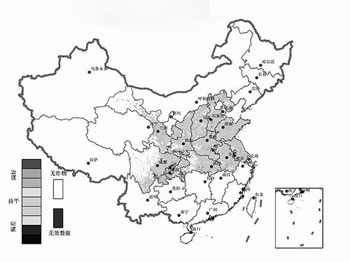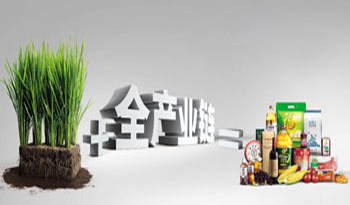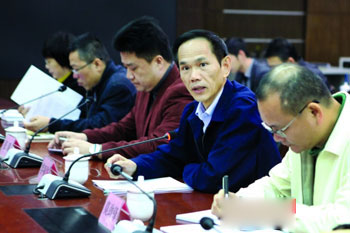Agricultural situation is expected to report in real time, remote sensing and monitoring made in China.
Original title: agricultural situation monitoring is expected to report quickly in real time.

Photo Source: CropWatch
This was a long time ago.
In 2003, China has a high degree of dependence on foreign soybeans, importing large amounts of soybeans from the United States, Brazil, Argentina and other countries every year. At that time, China's international influence was not as strong as it is today. The "authoritative" benchmark data released by the USDA that year showed a sharp reduction in soybean production in the United States and even around the world, causing soybean futures and spot prices to soar at that time. Due to the shortage of domestic soybean supply, China still imports large quantities of soybeans from the United States at high prices. Later, it turned out that the soybean production in the United States was basically the same as in previous years, and China was thus trapped and became a pain for many years.
"something similar happened in 2008." Dr. Zeng Hongwei of the Institute of remote Sensing and Digital Earth of the Chinese Academy of Sciences told China Science Daily that in fact, China already had its own remote sensing and rapid reporting system for agricultural conditions (CropWatch) in 2003, but the influence of CropWatch was not high at that time. "if we had only trusted our own information at that time, we could have hindered the news (reduction of soybean production)."
Since then, the CropWatch team led by Wu Bingfang, a researcher at the Institute of remote Sensing Earth, has firmly believed that it is necessary to improve the level of remote sensing monitoring of agricultural conditions and improve the transparency of global agricultural monitoring reports.
Report on remote Sensing Monitoring of Agricultural situation in China
Agricultural monitoring report is an important basis to evaluate the current crop growth, yield and other key information in a country, a region and even the global scale. According to Zeng Hongwei, the first remote sensing quick report on China's agricultural situation came not too late. Since the Institute of remote Sensing and Digital Earth of the Chinese Academy of Sciences initially established China's agricultural situation remote sensing monitoring system (CropWatch) in 1998, the first issue of China's agricultural situation remote sensing quick report was released in August of that year. However, the monitoring at that time was limited to the main grain producing areas of our country.
That changed in 2002. Since 2002, the monitoring scope of CropWatch has been extended to the whole world, and gradually expanded to 27 countries in 2005. By 2013, the agricultural information of 31 major food-producing countries in the world will be under the monitoring of CropWatch. So far, CropWatch has released 99 issues of Global Agricultural remote Sensing Fast report.
The reporter opened CropWatch's global website and selected "Chinese" from six languages to enter, and the latest agricultural remote sensing quick report came into view: in the first ten days of November 2015, the growth of winter wheat in China was at the average level of nearly five years. During the last monitoring period, the deviation in the growth of winter wheat caused by precipitation deficit in the central and eastern part of Henan Province was alleviated.
Every year, the CropWatch team will timely submit accurate grain production monitoring information to the relevant national departments, which provides decision-making support for our country to grasp the global grain production information, and the monitoring results have been adopted by the Central Office, the State Office and other departments many times.
According to IP, since the Chinese-English bilingual "Global Agricultural situation remote Sensing Express report" was first released online for free in 2013, the global agricultural monitoring report from China has been viewed and downloaded more than 30, 000 times and reached more than 110 countries around the world.
"especially for the vast number of third World countries, after they get the information, they have a good understanding of the food situation in their own countries." Zeng Hongwei said: today, the international influence of CropWatch has surpassed that of the European Union to become the second largest agricultural remote sensing monitoring system in the world after the United States Department of Agriculture, significantly improving the transparency of global agricultural remote sensing monitoring.
Bigger goals and challenges
The CropWatch science team is not satisfied. According to another team member, Dr. Zhang Miao, they want to make agricultural monitoring more refined on a global scale-the grid resolution of remote sensing monitoring on a global scale is now measured in kilometers, and they hope to fine the grid to 100 meters in the future; in terms of time resolution, the monitoring time frequency is increased from 10 days to 5 days.
"the increase from 10 days to 5 days, from 1 km to 100 meters is very helpful for us to accurately grasp the global agricultural information." Zeng Hongwei told reporters that the meticulous monitoring results indicate that users can make more detailed decisions and solve agricultural production problems in a more targeted manner.
The significance of improving resolution is undoubtedly positive, but it also means greater challenges. In addition to the need for higher resolution remote sensing satellites, the algorithms of monitoring models, data storage and transmission, and calculation of payloads all mean great pressure.
With the continuous progress of remote sensing monitoring technology, the global coverage of high-resolution data is becoming more and more abundant, and remote sensing data is no longer a bottleneck; monitoring model algorithms are no longer a problem for team members working around the world; but this computing system has always been a worry for the CropWatch team.
According to Zeng Hongwei, the current server of the CropWatch system is "OK to meet our current needs", but when large-scale operations are needed, "after running on Friday, we will have to wait until next week to see the results."
However, with the improvement of accuracy, this embarrassment will be aggravated. Zhang Miao said that the improvement in space and time accuracy around the world and even in China will lead to a sharp increase in the scale of data and images, and the already tight servers, "processors are down."
"We have very high requirements for computing, and it is also necessary in terms of the time cost of scientific research. However, if you look at our current office environment, "Zeng Hongwei said, pointing to the tense office," we don't want to buy a larger computing system.
So when they heard the news of the "Earth numerical Simulation device" prototype system jointly developed and released by the Institute of Atmospheric Physics of the Chinese Academy of Sciences and dawning of the Chinese Academy of Sciences this year, which is a high-performance computing system specially used for earth system scientific computing, the CropWatch team was very excited: "Great, with this, the problem of computing requirements will be solved."
"this is our urgent need." Zeng Hongwei told reporters that at present, the CropWatch team has become the user unit of the device, and once the "Earth numerical Simulation device" project is really established, the global agricultural monitoring data will not be updated every four months, but will hopefully be updated in real time.
"We hope that the display of agricultural information in the CropWatch system will be updated in real time. If the operation can be done quickly, it can be done. By then, the meaning will certainly be different. " Zeng Hongwei said. (our reporter Zhao Guangli)
- Prev

Ten modes for agricultural operation to gain advantages and make money at most
Ten modes for agricultural operation to gain advantages and make money at most
- Next

Jiangmen's accurate poverty alleviation is expected to be done by the end of the year.
Jiangmen's accurate poverty alleviation is expected to be done by the end of the year.
Related
- A course of planting techniques and methods on how to grow carrots
- How to plant the latest tulips?
- Is it better to pick tea in the morning or in the afternoon? When is the best time for tea to be picked? what is the third or fifth tea?
- Launch Yuanxiao Happy combination Haocha + Tea Yuan healthy Taste
- Penghu Tourism "Fireworks 20 Parade with You"
- 2022 West Lake Happiness holds "Digital Revitalization Voucher" and draws iphone13 and laptop.
- Banqiao Fuzhou social houses are designed to change start-up combined with police elimination to create a safe and livable environment
- The convenient measure of "mechanical weeding" in Xinbei has been abused and the Agriculture Bureau has imposed heavy penalties on the illegal land consolidation.
- Changgeng University Joins Hands with Four Memory Factories to Rescue Memory Talent Shortage
- The list of Taiwan's top 100 MVP managers is listed by the Director-General of the Farmers' Association of Sanxia District.

